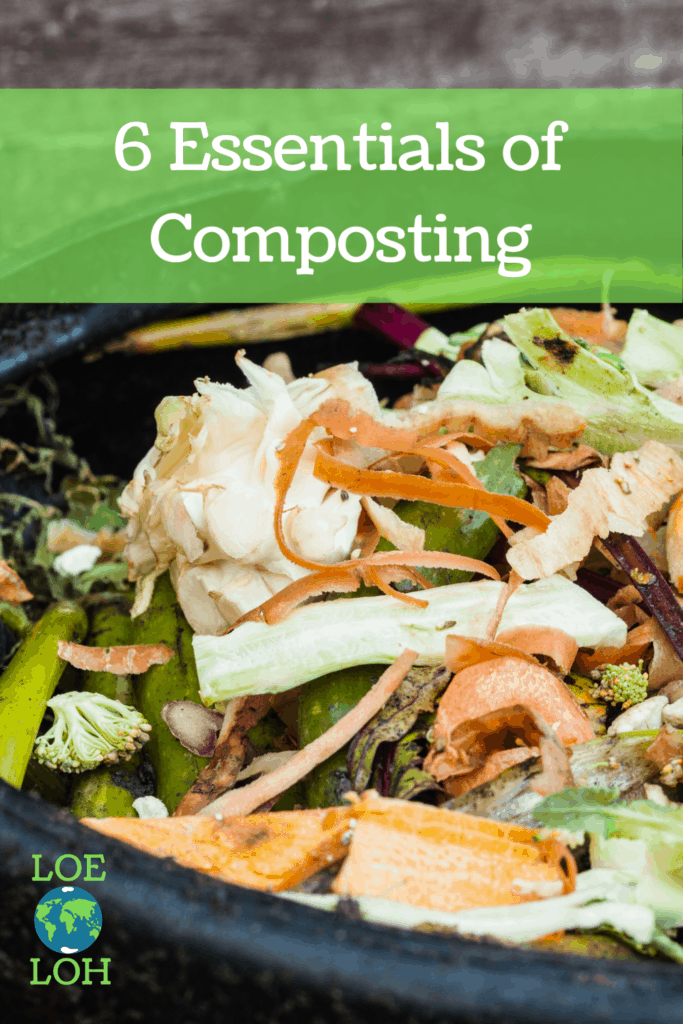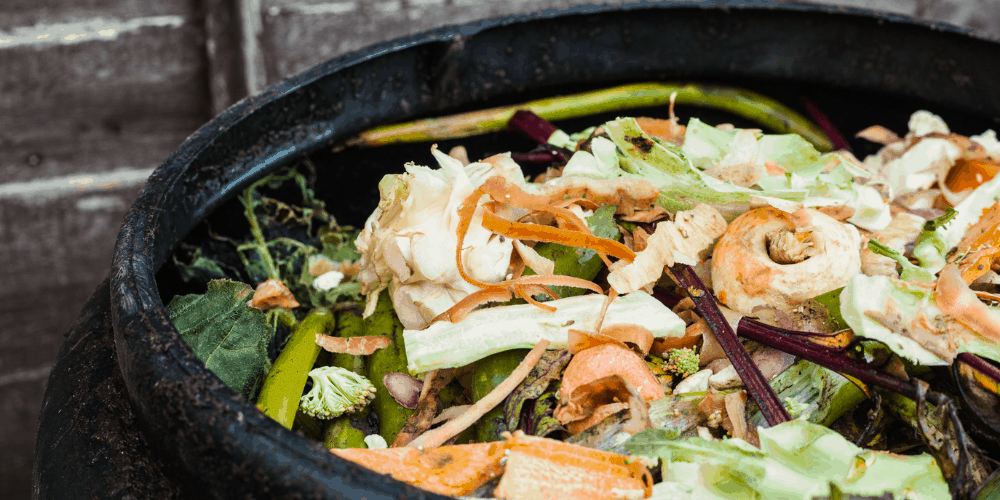Around the world we generate over 3.5 million tons of waste a DAY. About 44% of what is thrown in landfills are food scraps and yard waste. Tossing organic waste*, like food scraps and yard waste, into landfills is a sorely missed opportunity. Trashed organic waste can be transformed into life nurturing compost. Here will review the connections of compost to climate change and regenerative living. And also the 6 essentials of composting to get you started.
*Quick side note: Before we continue, I want to clarify organic waste. Organic waste refers to waste which comes from living organisms not necessarily waste only from organically grown plant or animal products.
The Connection of Composting to Climate Change and Regenerative Living
Compost and Climate Change
Beginning with how composting is connected to climate change. When microbes breakdown organic waste in a low oxygen environment like landfills, they emit methane, a powerful greenhouse gas. By providing an environment that is higher in oxygen, like a compost heap, we are preventing the production of methane.
Furthermore, compost is chock full of nutrients and can be used at home as fertilizer. Using compost instead of store bought fertilizer cuts fossil fuel emissions required to make and transport fertilizer. Also, not spending money on fertilizer saves you money! Additionally, when we add compost to soil, the composted organic waste feeds the microbes in the soil. These microbes store carbon in the soil, preventing carbon in other forms like carbon dioxide to escape in the atmosphere. Hello, carbon sequestration! When we compost we are preventing production of additional greenhouse gases and we are storing carbon in the soil. These are important techniques in addressing climate change.
Compost and a Regenerative Lifestyle
When compost is added to soil, it restores the health of soil, contributing to the regeneration of the ecosystem. For example, compost in soil feeds the bacteria and fungus in the ground. This community of microbes in the soil is called a microbiome. The microbiome in turn provides essential nutrients from the compost to growing plants through their roots. Compost also improves the ability of soil to hold on to moisture, and prevents plant diseases. Composting is a terrific practice that repurposes waste into beneficial material which regenerates our soils and our ecosystems. This makes composting valuable in a regenerative lifestyle.
The capacity of compost to address climate change and to regenerate the soil of our ecosystem is incredible. And all of this potential comes from items we would otherwise throw away. So, now, how do you make your own compost? Compost, also called gardener’s gold, is easy to get going, you only need these 6 essentials of composting to begin.
The 6 Essentials of Composting
When composting at home, you are facilitating the natural process of decomposition of organic waste into nutrient rich compost. These 6 essentials of composting will get you started.
1. Microbes
Microbes are tiny and mighty organisms that live everywhere. There are some compost starters, that include microbes to speed up the decomposition of your compost bin. However, the organic waste you add to your compost collection is already full of microbes, ready to decompose, and absolutely free! Gotta Love Our Earthly Magic. If microbes are already present in our organic waste, why are they on the essentials list? The reason microbes are on the list of essentials of composting is because they breakdown most of the organic waste into compost. Thus, without microbes we won’t have compost. Also, nearly everything else on this list is here to keep our mighty composting microbes happy!
2. Brown Waste
Carbon rich brown waste includes all kinds of dried papery waste. The dried brown waste balances the moisture from green waste.
The following are considered brown waste.
- dried leaves
- dried grass clippings
- straw
- hay
- sawdust
- shredded paper or newspapers (not glossy paper like magazines)
- cardboard (not glossy cardboard)
3. Green Waste
Nitrogen rich green waste mostly consists of your kitchen scraps. Green waste usually contains a lot of water, which is balanced by dry brown waste.
The following are examples of green waste.
- fruit and vegetable peelings or scraps
- egg shells
- coffee grounds
- unbleached coffee filters
- tea bags (remove any staples, or glossy tea tags)
- fresh green yard clippings or trimmings
Generally, it is not advised to include animal products in home compost bins. Animal products like dairy, meat, bones and pet waste in compost bins can start to smell They also can attract animals like raccoons and rats, and encourage growth of harmful bacteria like E. coli. There are some compost setups that can take animal products. I have not worked with these myself. If you have, please feel free to share your experience in the comments.
4. Air
Air is key to ensuring an oxygen rich environment for microbes that grow aerobically (with oxygen). If there is not enough oxygen in your compost pile, microbes that grow anaerobically (without oxygen) will thrive. These anaerobic microbes may cause your compost to stink. You can add air into your compost by turning or stirring your pile.
5. Water
Have you heard the phrase, “Water is life”? To keep our compost microbes alive and happy, we want to make sure there is enough water. On the other hand, we don’t want our compost pile to be soaking wet. It is recommended to keep your compost about as wet as a wrung out sponge.
6. Location
Where do you want your compost magic to happen? This is completely up to you. If you do not have access to outside space, there are plenty of options to compost indoors. You can compost where it is dark and dry, like under your kitchen sink, closet, basement, or in your garage . Balconies are a great place to set up your compost as well. Of course, you may set up your compost in your yard.
Once you have picked a spot, now you can choose what container to compost in. You can compost in a bin, with the help of worms, in a compost tumbler, or within some extra wire fencing. Pick a location and a container that works best for you.
You may even have access to a local compost service at your farmer’s market, a community garden, a municipal compost service, or a compost service for a fee. See if your family, friend, or neighbor who composts, is able to take your organic waste.
A Few Important Compost Tid Bits
There are several organic waste items to NOT include in your compost bin for a variety of reasons. Check out the EPA website for more information on what NOT to put in your at home compost, including black walnut leaves or twigs, oils, coal ash, and more.
Brown and Green waste ratio or the Carbon Nitrogen Ratio is important to keep your compost collection healthy and to prevent your compost from smelling. If your compost starts to smell adding more Brown waste may fix the issue.
The decomposition magic of compost, that gets us from coffee grounds and egg shells to gardener’s gold, takes time. The method and conditions of your compost will determine how long it takes, usually about 3 to 6 months.
Choose a small lidded container to collect your kitchen scraps during the week. Keep this container in your freezer until it is ready to be added to your compost. By storing this container in your freezer prevents smells and insects.
With these 6 essentials of composting, you have the foundation to get your own compost going. Happy Compost=Happy Microbes=Happy Soil= Happy Plants=Happy You! This is a lot of happy to go around. So, start composting already!
Image credit: Close up of home compost bin. By Science Photo Library.


